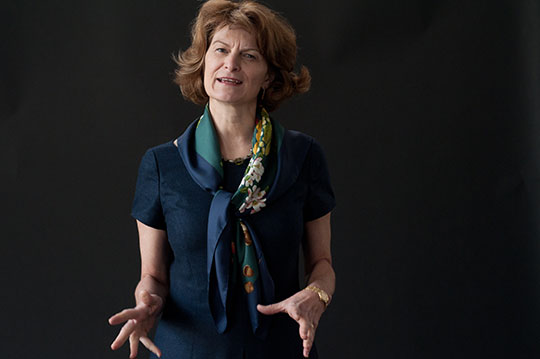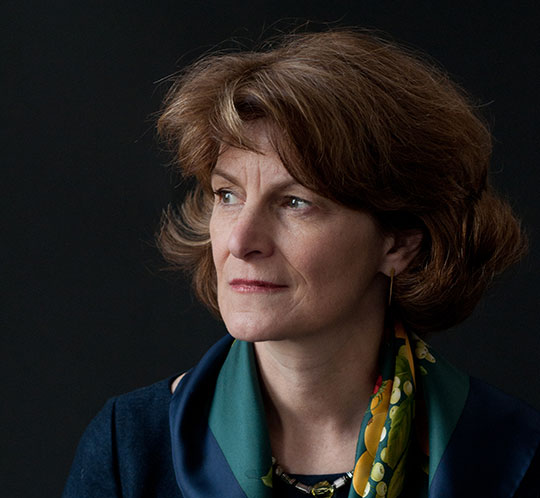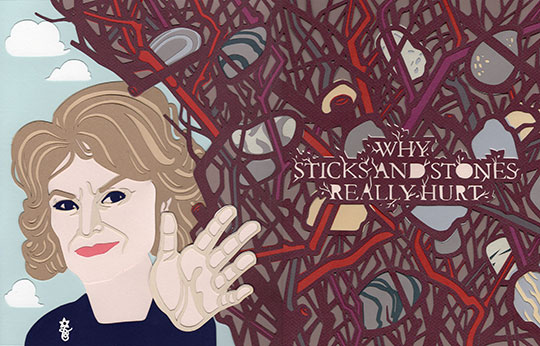Why Sticks And Stones Really Hurt
Marla Brassard has helped put psychological abuse on the world's radar
Marla Brassard has helped put psychological abuse on the world’s radar
By JOE LEVINE
In the 1980s, when some superintendents in eastern Canada were phasing out psychological abuse and physical punishment of children in their schools, Marla Brassard ran a series of workshops for teachers in rural towns on nonviolent techniques for managing classrooms.
Initially, the teachers—mostly men who had grown up in the area—“tilted back in their chairs with their arms folded across their chests,” recalls Brassard, Professor of Psychology and Education and coordinator of Teachers College’s doctoral program in school psychology. “They thought I was going to take away the only means they had for maintaining control.” But the floodgates opened when she asked the group about their own student days. Nearly everyone told stories of teachers calling them names, punching them and throwing them against lockers. One man remembered being chained to the leg of a desk.
“There were multiple examples, and they were all legal,” says Brassard.
But for her, the violence was secondary. “What I found really heartbreaking was how few of them could recall anything positive a teacher had done. One guy remembered that his teacher had scribbled ‘Good’ over a section of a paper he’d written. Another said a teacher had once complimented him on his throwing arm. Beyond that, nothing their teachers had done had ever made them feel cared for, valued or competent. So they themselves took little joy in their work, and they had no experience of praising kids, of listening to them or of trying to develop any kind of a relationship with them.”
LOOKING BELOW THE SURFACE
OVER THE PAST 30 YEARS, Brassard has been among a handful of pioneers in her field to bring global attention to the psychological abuse and neglect of children by parents, teachers and other caregivers. In a career that has ranged from consulting in juvenile death-penalty cases to evaluating sexually abused teens, she has focused on the psychological dynamics that underlie emotionally damaging relationships.
“If you look at the harm from physical abuse, unless it’s very severe, it’s almost all accounted for by psychological abuse,” says Brassard, a tall woman with finely etched features and a warm, energetic manner. “If your dad throws a brick at you and misses, the message is still that he cares so little about you that he would put you at risk. And it’s the same thing with sexual abuse—the idea that a parent or other caregiver would exploit you in that way when you’re avoiding them at all costs and wearing three pairs of pajamas to bed. That’s what screws kids up.”
Beyond cases reported to child protective services and the police, random phone surveys reveal that 90 percent of American parents engage in some form of psychological aggression with their children age 2 and older, and that more severe psychological aggression occurs with about 10 to 20 percent of toddlers and 50 percent of teens. Children from lower-income families (those earning less than $30,000 annually) are 13 times more likely to have been abused than those from higher-income families.
The resulting harm is indisputably real. In a study that has followed children in Springfield, Massachusetts, through middle school (funded by the Spencer Foundation) and now into young adulthood (funded by the Beth and Michael Kasser Foundation), Brassard and former doctoral student Kera Donovan found that those subjected to more than one or two instances of verbal aggression by their mothers in a single year have had higher incidences of delinquency, depression, low self-esteem, social isolation and victimization by peers.
Yet psychological abuse remains poorly studied, and there are still people, including those whose work relates directly to children’s well-being, who refuse to recognize its importance.
“We all know what it’s like to be verbally or behaviorally attacked or rejected,” Brassard says. “So people say, ‘Well, yeah, that happened to me, and I turned out fine.’ What people don’t realize, and what we now know from research, is that psychological maltreatment destroys marriages, friendships and parent-child relationships.”
It’s also hard for the state to intervene in a family where psychological abuse is occurring. “You can order someone to stop hitting or sexually abusing their kid, but you can’t really order a parent to change the whole tenor of their relationship with their child.”
AN UNEXPECTED PATH
BRASSARD DID NOT SET OUT TO STUDY psychological abuse. After earning a Ph.D. in school psychology at TC in 1979, she worked for a year as a school psychologist in Princeton, New Jersey. Then she became an assistant professor in the school psychology program at the University of Utah, where she studied learning-related issues. While there, she was approached by a doctoral student, active in the Junior League, who had set up one of the first respite-care centers for families at risk for abusing their children.
“She asked me to do pro bono assessments of the kids,” Brassard recalls, “and then co-lead therapy groups for sexually abused children. There was no literature on the subject of sexual abuse; the only two articles you could find in the university library were on incest among aboriginals. So we ended up doing some studies together on child sexual abuse.”
Brassard also began to theorize about why people abuse. “Most of us operate on a two-pronged strategy in relationships,” she says. “The first is positive. As good teachers, parents or friends, we get others to like us by cooperating with them, being fun to be with, pleasing them. We try hard to keep the relationship working because it means a lot to us. The second strategy is about being aggressive and coercive. Everyone needs to be able to defend themselves and those they care about, but some people who have been raised in rejecting or unhappy families with a lot of conflict know only that strategy. They’re one-trick ponies, and many—but not all—end up in coercive cycles, raising their kids the same way their parents raised them.”
In 1983, in part because of her broader understanding of what motivates maltreatment, Brassard was tapped by Stuart Hart, the newly elected President of the National Association of School Psychologists, to co-chair the first (and still the only) international conference on psychological abuse.
“We brought together a group of really influential people from different fields who were in a position to make genuine contributions,” recalls Hart, who is now a professor emeritus at the Indiana University School of Education. “It was really the moment that a field was born—when the people who could make contributions got together for the first time to go into depth and get to know one another.”
Brassard and Hart subsequently won one of the first federal grants ever awarded for research on psychological abuse and used it to develop a set of operational definitions and quantitative measures. (Their observational measure of psychological maltreatment, for example, can distinguish carefully matched maltreating parents from non-maltreating parents on the basis of just 15 minutes of videotaped parent–child interaction.) They have remained close friends and collaborators ever since.
“Marla has great research skills—she understands the necessary steps to produce empirical data that give you a firm footing to assess protracted interventions,” says Hart. “She also has great insight into how families work.” These qualities, he adds, together with a genuine kindness toward other people, have made Brassard “the right person at the right time” to advance the field.
In 1995 the definitional framework created by Brassard and Hart became, in revised form, the Guidelines for Suspected Psychological Maltreatment of Children and Youth of the American Professional Society on the Abuse of Children. These guidelines are now widely used around the world by psychologists who have been asked to make evaluations in court cases or create treatment plans. They cover:
·
spurning (shaming, ridicule, persistent criticism and punishment, public humiliation);
·
exploiting and corrupting (modeling or encouraging inappropriate behaviors, such as prostitution, criminal activity, substance abuse or violence);
·
terrorizing (physically harming, endangering or abandoning a child or his/her loved ones or objects);
·
isolating (denying opportunities to meet a child’s needs for interaction and communication with others); and
·
denying emotional responsiveness, which includes failing to express affection, caring, love or interest in a child.
The last category may be the most damaging of all. For example, in a 1970s study of low-income women in Minneapolis who had recently had their first babies, the average IQ of infants who were fed, clothed and changed without any kind of emotional interaction (hugging, kissing, cooing) dropped from average levels at age 1 to the equivalent of being nearly mentally retarded at 18 months.
“We’re designed, as a species, to learn about the world in an intensely emotional and social context, and we’re set up to do it with Mom and those close to her in the first year,” Brassard says. “So if you’re just propped up and given a bottle, and touched only when you’re changed and maybe when you’re fed, it’s devastating to your social and emotional development.”
FIXING THE PROBLEM
HOW CAN PSYCHOLOGICAL ABUSE BE STOPPED? For Brassard, the most effective solution would be a cultural change.
“In Western Europe, many countries have outlawed mental injury and corporal punishment by parents and teachers,” she points out. “They also provide social services that reduce the stresses on families, such as prenatal care for poorer women, trained home visitors after the birth of a child or if a family is struggling, and income support for single parents. The countries that first did this, like Sweden, have much lower incidences of abuse and child problems than we do. But here in the U.S., it’s still legal in many states for parents and school personnel to hit and say demeaning words to kids.
“The U.S. and Somalia are the only two countries that haven’t yet ratified the 1989 United Nations Convention on the Rights of a Child, which says that every child has worth and is entitled to respect for their human dignity and protection from psychological and physical forms of abuse,” she continues. There would seem to be little to oppose in such a document, but “it seems to violate our notion of the sanctity of the family.”
Meanwhile, in lieu of a proactive approach, Americans “wait until kids from maltreating and dysfunctional families are broken, and then we try to fix them,” Brassard says. “We have this weird outlook that, when kids are little, abuse is perpetrated by horrible parents—and then suddenly, when kids become teenagers, our perspective flips and the teens are the horrible ones who mistreat their parents and need to be shipped off to group homes.”
Still, there are interventions that can change the dynamics in abusive families. “The most effective parenting programs start by teaching parents how to read a child’s emotional signals, show love and be caring toward their kids,” Brassard says. “That has to come first, because in abusive homes, the kids and parents may hate each other, even if there’s still a bond between them. So the parent has to learn to pay attention to the child and to the child’s interests, and only then move on to learning positive and consistent discipline techniques.”
Ultimately, children themselves may offer the most fertile ground for change. “The good news,” Brassard continues, “is that there is an awful lot we can do to intervene at the school experience level. That’s where we can get the biggest intervention bang for our buck. Give children alternative relationships with caring adults—relationships in which they feel cared about, can demonstrate competence and develop a sense of self-efficacy and can learn that others can be trusted. Research shows that these adults can be teachers, especially same-sex, or coaches, school psychologists, lunchroom aides, janitors or adults in the community such as pastors, friends’ parents and other family members.”
In Springfield, where she has conducted her longitudinal study of middle-school children, Brassard interviewed a sixth-grader who was having suicidal thoughts. The girl’s parents were divorced, and her mother, with whom she had been very close, was now working a demanding full-time job.
“The girl was a good student in a gifted-and-talented program, she had friends, she liked her teacher,” Brassard says. “But boys in the class were repeatedly harassing her and other girls, making comments about the size of their breasts and how they would be in bed. She was miserable, and she couldn’t tell her mom.”
Was the mother guilty of abusing or neglecting her daughter? “No,” Brassard says. “But it says how much children need supportive adults in their lives. That’s their whole world.”
Published Thursday, Dec. 15, 2011


